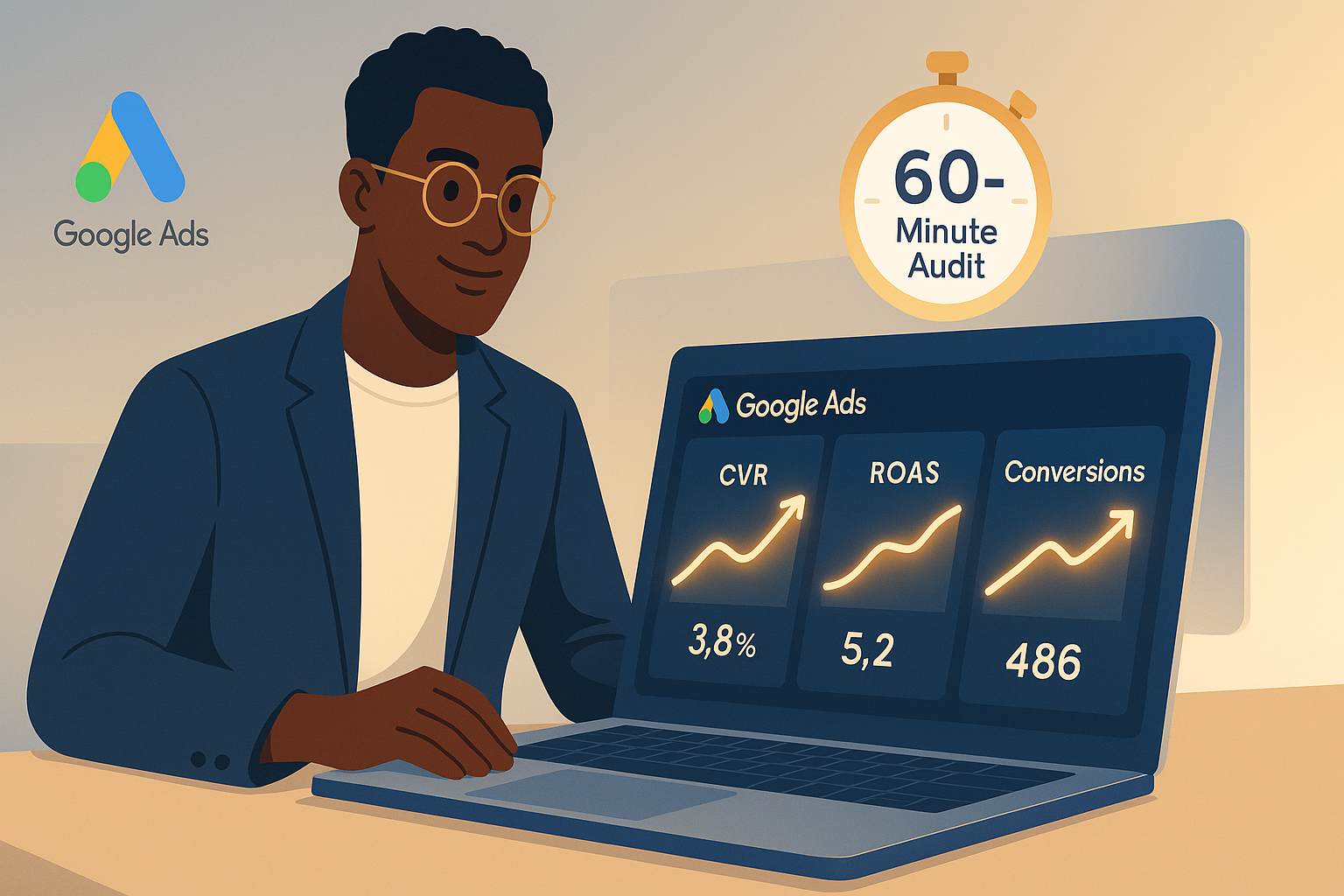
Introduction
You log into your Google Ads account — and your stomach sinks.
The spend is sky-high, conversions are flat, and ROAS looks worse than ever. You’ve tried tweaking bids, testing ads, and even adding new campaigns, yet nothing changes.
Before you hit the panic button or rebuild everything, stop. Most struggling Google Ads accounts don’t need a complete overhaul — they need clarity.
That’s where a Google Ads audit comes in. In just 60 minutes, you can uncover wasted spend, misaligned targeting, broken tracking, and structural issues that quietly eat your budget. Whether you’re managing eCommerce campaigns with Performance Max or running lead generation via Search and Display, this fast and systematic audit will pinpoint exactly what’s holding your performance back.
In this guide, you’ll discover the proven 60-minute Google Ads audit framework I use to help clients achieve consistent 3–5x ROAS and scale profitably. This isn’t theory — it’s a repeatable process designed for marketers who need results fast.
The 60-Minute Google Ads Audit Framework (Step-by-Step Process)
Your time is limited, so every minute counts. Here’s the structure you’ll follow:
-
0–10 min: Account Overview & Structure
-
10–20 min: Conversion Tracking
-
20–35 min: Campaign & Keyword Audit
-
35–45 min: Ad Copy & Creative Review
-
45–55 min: Audience & Bidding Strategy
-
55–60 min: Reporting & Action Plan
Let’s dive deeper into each stage of the audit.
Step 1: Audit Your Google Ads Account Structure (0–10 Minutes)
The first step of your Google Ads audit is getting a high-level view of your account setup. This reveals inefficiencies, mismanagement, and potential duplication.
What to check:
-
Account linking: Ensure GA4, Google Merchant Center, and CRM tools (like HubSpot or Salesforce) are properly connected. Unlinked accounts cause data gaps that lead to poor decisions.
-
Naming conventions: Campaigns and ad groups should follow a consistent naming logic (e.g.,
Brand_CampaignType_FunnelStage). This improves clarity when scaling or reporting. -
Campaign segmentation: Verify that your campaigns are separated logically by intent, product category, or audience type.
-
Brand vs. non-brand: Always separate brand from non-brand campaigns. Mixing them skews ROAS and hides inefficiencies.
-
Duplication check: Identify keywords appearing in multiple campaigns with overlapping match types.
-
Spend allocation: Apply the 80/20 rule — ensure 80% of conversions come from 20% of campaigns.
-
Quick wins: Pause low-impression ad groups and remove outdated experiments.
Quick Win: Separate your brand and non-brand campaigns today — it’s one of the fastest ways to gain accurate performance data.
Step 2: Audit Google Ads Conversion Tracking & Measurement (10–20 Minutes)
If your tracking is broken, every optimization decision is wrong. The most critical part of your Google Ads audit is validating that your data is accurate.
Actionable steps:
-
Review all conversion actions: Go to Tools → Conversions and deactivate duplicate or outdated actions.
-
Define primary conversions: Focus optimization around one or two high-value actions (like purchases or qualified leads).
-
Check Tag Manager & GA4 integration: Use Preview Mode to test whether conversions fire correctly.
-
Attribution model: Avoid last-click. Use Data-Driven or Position-Based attribution for more accurate credit distribution.
-
Offline imports: For lead generation, confirm CRM integrations with HubSpot, CallRail, or WhatConverts.
-
Simulate conversions: Submit a test form or purchase flow to verify data is captured in real time.
-
Track conversion value: For eCommerce, ensure revenue data is passed back into Google Ads.
-
Common red flags: Pixel delays, misfiring tags, and duplicate conversions in GA4.
Pro Tip: Always compare Google Ads conversions to GA4 and CRM data weekly. Even small discrepancies can indicate serious tracking issues.
Step 3: Google Ads Campaign & Keyword Audit (20–35 Minutes)
Once your tracking is solid, move to campaign and keyword performance. This step identifies wasted spend and missed opportunities.
A. Search Campaigns
-
Search Terms Report: Check for irrelevant queries draining budget. Add negative keywords where needed.
-
Intent alignment: Focus on commercial-intent keywords (e.g., “buy,” “pricing,” “quote”) instead of purely informational ones.
-
Ad group structure: Group by theme or funnel stage. Avoid overly narrow SKAGs unless you have high search volume.
-
Bidding strategy: Ensure your bidding aligns with data volume. For smaller accounts, use Maximize Conversions; for stable data, use Target ROAS.
-
Impression share: Review lost IS due to budget or rank.
B. Performance Max & Shopping Campaigns
-
Asset group structure: Each group should reflect a unique product line or audience segment.
-
Merchant Center health: Fix feed errors (missing GTINs, low-quality images, disapproved items).
-
Item-level ROAS: Review SKU-level data and reallocate spend from low-performing to top-performing products.
-
Feed optimization: Use descriptive, keyword-rich titles and clean product images.
C. Display & Discovery Campaigns (if applicable)
-
Placement review: Exclude poor-performing sites or irrelevant placements.
-
Engagement rates: Low CTR? Refresh your creative and messaging to align with user intent.
Quick Win: Tighten keyword targeting using negative keywords — it’s the fastest way to improve CTR and reduce wasted spend.
Step 4: Audit Google Ads Ad Copy & Creative Performance (35–45 Minutes)
Your ads are the face of your campaign. Weak creative kills conversions — even with perfect targeting.
Here’s what to review:
-
Responsive Search Ads (RSA): Use all headline and description slots. Pin proven headlines while testing new variations.
-
Ad strength: Aim for “Excellent.” Use asset performance ratings to refine your messaging.
-
CTA clarity: Replace “Learn More” with actionable phrases like “Get a Free Quote” or “Shop Now.”
-
Keyword relevance: Ensure ad copy aligns tightly with ad group themes to improve Quality Score.
-
Extensions: Use all available extensions — sitelinks, callouts, snippets, and lead forms.
-
Creative consistency: Align messaging with landing pages and other platforms like Facebook and YouTube.
-
For Shopping & PMax: Use lifestyle photos, clear titles, and product highlights to attract more clicks.
Pro Tip: Refresh creative every 45–60 days. Even high-performing ads fatigue over time.
Step 5: Google Ads Audience & Bidding Strategy Audit (45–55 Minutes)
Targeting the right audience ensures your budget works smarter, not harder.
What to assess:
-
Audience layering: Use remarketing lists, custom segments, and in-market audiences.
-
Exclusions: Remove converters, internal traffic, irrelevant geos, and low-intent segments.
-
Demographics: Trim underperforming slices by age, gender, or device.
-
Geo-targeting: For local businesses, refine radius targeting and exclude non-converting regions.
-
Bid strategy alignment: Avoid overbidding in awareness campaigns. Prioritize high-ROI segments.
-
Budget pacing: Reallocate budgets to best-performing campaigns weekly.
-
Seasonality adjustments: Use Smart Bidding’s seasonal modifiers for promotions or holidays.
Quick Win: Combine audience data with keyword intent — this double-layer targeting boosts efficiency dramatically.
Step 6: Google Ads Audit Report & Action Plan (55–60 Minutes)
Now consolidate everything into actionable next steps.
Key Actions:
-
Dashboard: Build a Looker Studio dashboard for ROAS, CPA, CTR, and conversion volume tracking.
-
Action list: Prioritize the top 3–5 fixes with the highest ROI impact:
-
Fix broken conversion tracking
-
Pause low CTR campaigns (<1%)
-
Restructure campaigns by intent
-
-
Optimization checklist: Create a 7-day roadmap focused on immediate wins.
-
Review cycle: Schedule quarterly audits to maintain account health.
-
Communicate findings: Share results with your team or clients. Transparency builds trust and accountability.
Pro Tip: Include before-and-after benchmarks for every optimization. This quantifies your impact and reinforces ROI.
When to Rebuild Your Google Ads Account
Sometimes, patching things up won’t cut it. If you see multiple of these red flags, consider a complete rebuild:
-
No or unreliable conversion tracking
-
No separation between brand and non-brand campaigns
-
Dozens of overlapping campaigns with duplicate keywords
-
Budget heavily skewed toward low-ROI products
-
Mixed ad group themes or asset groups
-
Campaigns optimized for clicks, not conversions
A rebuild resets your data foundation — saving you more time (and money) long-term.
Best Tools for Google Ads Audits
Use these tools to simplify your audit and improve accuracy:
| Tool | Purpose |
|---|---|
| Google Ads Editor | Bulk edit and restructure campaigns |
| Looker Studio | Visualize data and trends |
| Tag Assistant & GTM Preview | Validate conversion tags |
| WhatConverts / CallRail | Track and import offline conversions |
| SEMrush / SpyFu | Analyze competitors’ ads and keywords |
| PMax Asset Group Checker | Evaluate creative coverage |
| Google Merchant Center Diagnostics | Fix Shopping feed errors |
External Resource: Check Google’s official Ads Help Center for advanced troubleshooting.
FAQs about Google Ads Audits
1. What is a Google Ads audit?
A Google Ads audit is a detailed review of account structure, performance, and tracking designed to uncover inefficiencies and improve ROI.
2. How often should I audit my Google Ads account?
Ideally, perform a full audit every quarter or after major changes to campaigns or products.
3. What tools do I need for a Google Ads audit?
Google Ads Editor, Looker Studio, SEMrush, and Tag Assistant are essential for accurate audits.
4. How do I know if my conversion tracking is broken?
Compare Google Ads data with GA4. Large discrepancies usually signal tracking issues.
5. Can a 60-minute audit really make a difference?
Absolutely — a fast audit helps identify wasted spend and broken tracking, which directly impacts ROAS.
6. When should I rebuild my Google Ads account?
If you find severe structure issues, missing tracking, or misaligned campaign goals, a rebuild is often faster and more effective.
7. What’s the difference between auditing and optimizing Google Ads?
Auditing identifies the problems; optimizing fixes them. Both are essential for sustainable growth.
Conclusion
A Google Ads audit doesn’t have to take days or require a high-priced consultant. In just 60 minutes, you can pinpoint what’s broken, prioritize quick wins, and realign your ad strategy for profitable growth.
The secret to successful media buying isn’t just spending more — it’s spending smarter. When you understand where every dollar goes, you can scale confidently and predictably.
Ready to take control of your ad spend?
👉 Book a Free Strategy Session today. Your account deserves clarity, not chaos.

Book Your Free Strategy Call Today
Book Your Call Today
Tags:

11/3/25 1:00 PM
